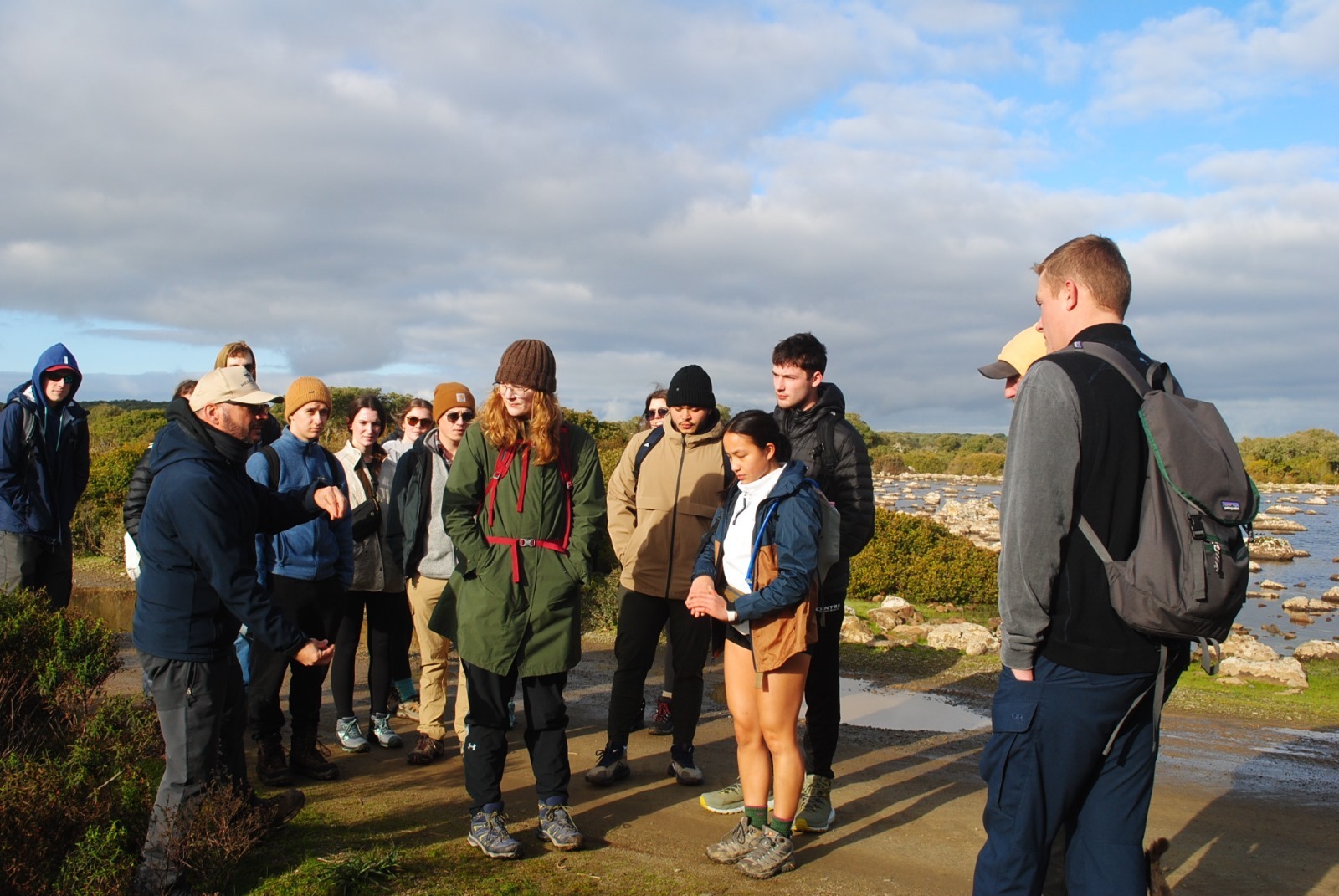
14 studenti dagli USA per studiare la colonizzazione della Sardegna
Si può conoscere la Sardegna parlando di aspetti sociali e non sempre e solo di attrazioni turistiche magari costiere?
Decisamente sì. Lo sta dimostrando in queste settimane il Professore Marc Démont del Centre College di Danville, Kentucky, Stati Uniti d’America, che è in Sardegna con 14 studenti per studiare da vicino gli aspetti legati alla colonizzazione dell’Isola.
Si tratta di un corso sviluppato dal professore grazie al sostegno della propria università, alla collaborazione con il pedagogista Alessio Murru e all’aiuto di molti attivisti sociali, artigiani, imprenditori e docenti sardi. Il corso è intitolato “Sardegna: Beyond the Colonial Postcard” (Sardegna: Oltre la Cartolina Coloniale), e si focalizza sulla nozione di colonizzazione interna presente negli studi subalterni sardi.
Gli studenti stanno analizzando criticamente la rilevanza di questa nozione, esaminando tre sfide distintive che l’isola deve affrontare: militarizzazione (e salute pubblica), energia verde, e lingua e identità sarda. L’obiettivo formativo per gli studenti è quello di valutare la pertinenza del quadro analitico della colonizzazione interna per comprendere meglio queste sfide apparentemente separate.
L’itinerario pensato da Démont e collaboratori prevedeva una prima tappa a Cagliari, dove Michela Foddis Saba ha guidato sapientemente il gruppo in un tour per il centro di Cagliari. Gli studenti sono rimasti affascinati dalla storia della città raccontata da Michela e dalla visita al museo archeologico all’esperienza virtuale di Nuragica. Il giorno seguente li ha visti spostarsi verso Barumini per visitare Su Nuraxi e la Giara.
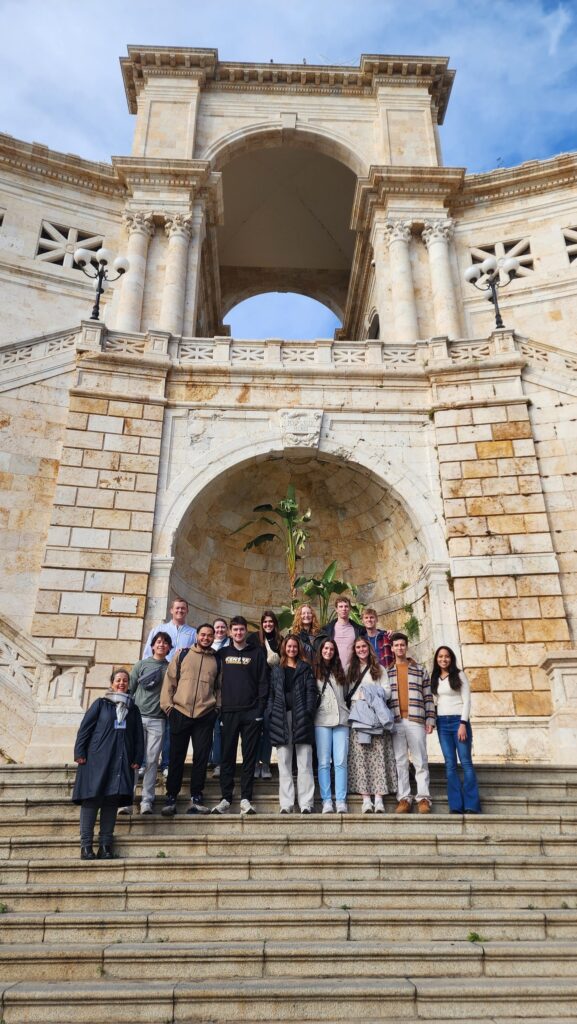
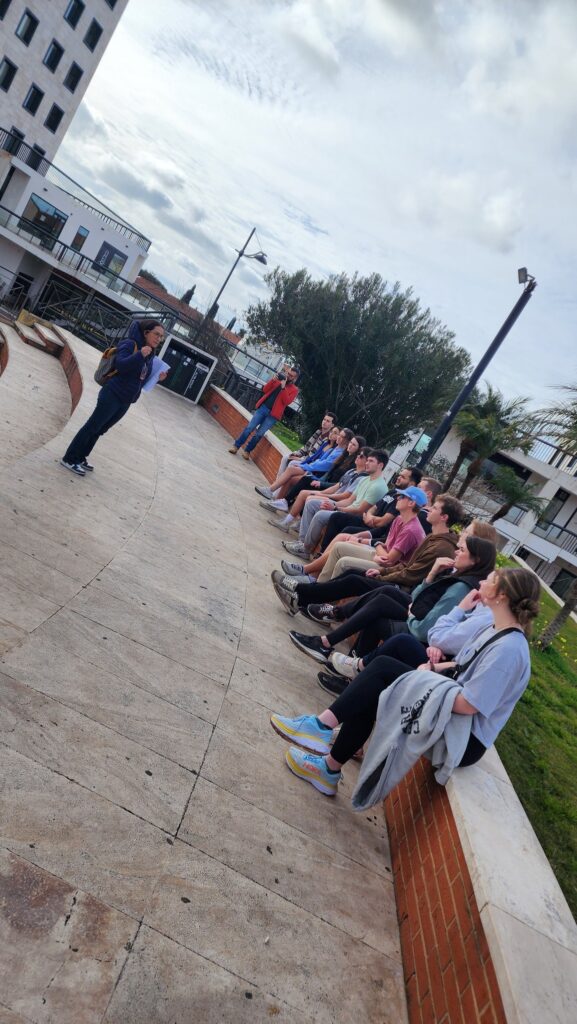
Gli studenti hanno poi avuto modo di conoscere la storia di Carbonia, del fascismo italiano, e l’importanza dello sfruttamento delle risorse minerarie nella storia della Sardegna, grazie alla grande professionalità di Federica Marrocu, guida e socia di ANS. Sempre a Carbonia hanno partecipato a una escursione sul Monte Crobu e a una conversazione sulla preistoria dell’isola con Manuel Cherchi, poeta e forte sostenitore della lingua sarda e della salvaguardia dell’isola. Il professor Démont è convinto che sia grazie a questo tipo di collaborazioni e di collaboratori (F. Marrocu, M. Cherchi, E. Putzolu) che il patrimonio di Carbonia possa essere valorizzato.
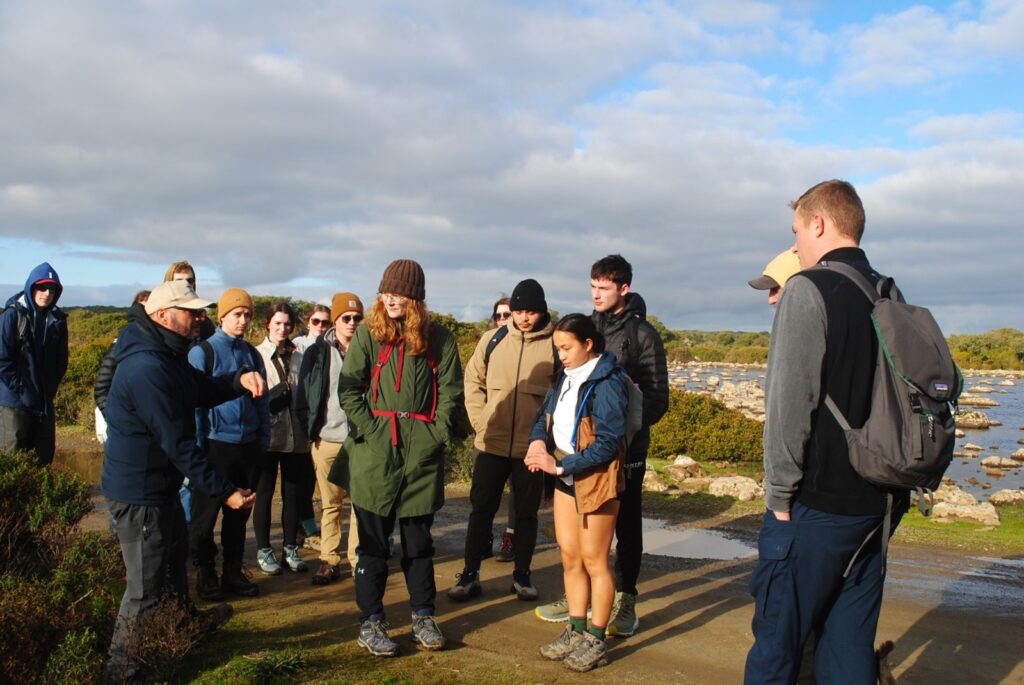
Qualcosa di totalmente opposto rispetto alle solite rotte turistiche, insomma. Infatti dal 16 al 20 gennaio i ragazzi si sono spostati verso il centro dell’Isola, nel Mandrolisai precisamente. Qui hanno ricevuto subito una calorosa accoglienza, dato che il 16, a Sòrgono, si accende Sa Tùvera e si celebra questo avvenimento intorno al grande fuoco.
Il giorno seguente hanno avuto modo di incontrare l’archeologa Viviana Cau, che li ha condotti in una full immersion di storia prenuragica e nuragica nei siti di Biru ‘e Concas e del Nuraghe arcaico Talei. I ragazzi si sono stupiti di come un tale patrimonio non riceva l’adeguata valorizzazione da parte delle istituzioni.
A seguire, e partendo proprio da questo interrogativo, ho avuto anche io il piacere di parlare con il gruppo e di raccontare quello che è a tutti gli effetti un problema politico e culturale. È stata l’occasione per parlare di cosa fa ANS – Assemblea Natzionale Sarda in termini di pressione politica nei confronti di chi governa la Sardegna e anche di crescita della coscienza natzionale all’interno della società.
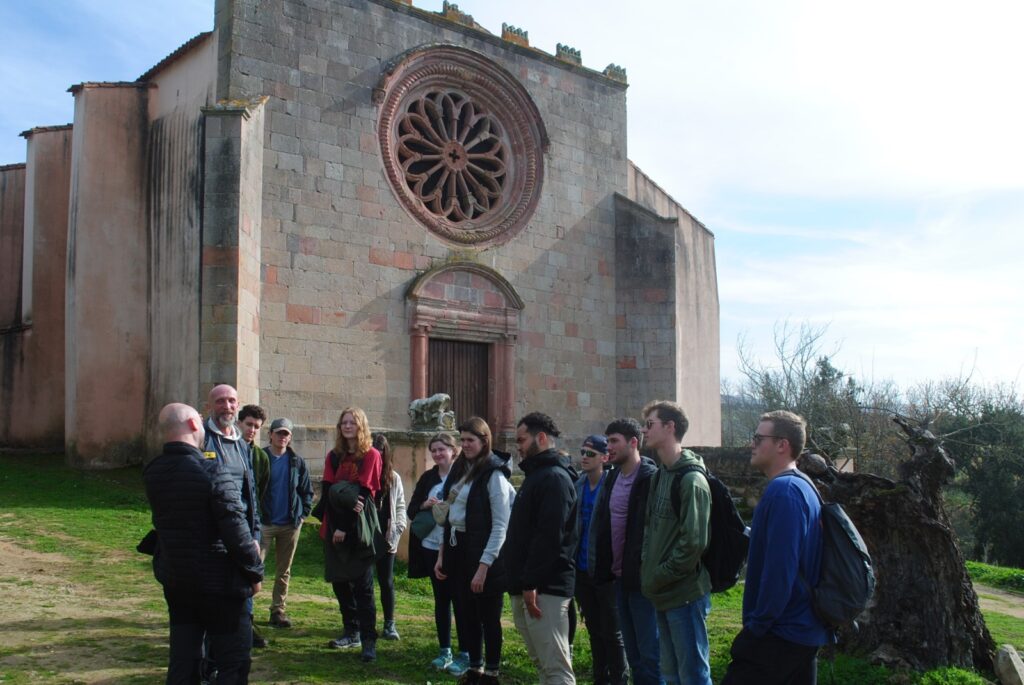
Nelle tappe successive gli studenti statunitensi si sono calati nella realtà locale al fine di capire come vivono le persone a queste latitudini, di che cosa si occupano e che saperi custodiscono.
Così, non è mancata una visita a una cantina, precisamente Cantina Mereu in località Monte Pischina. Il Mandrolisai è infatti terra di ottimi vini e gli studenti hanno visto come avviene la coltivazione della vite, che rappresenta una delle principali economie locali.
Francesca Mereu, de Il raccolto di Merea, e Marianna Carta hanno poi guidato i ragazzi in un laboratorio di trasformazione dalla materia prima grano al pane. Per non farsi mancare nulla, il gruppo si è cimentato anche nella preparazione della pizza, sotto la guida di Antoni Murru.
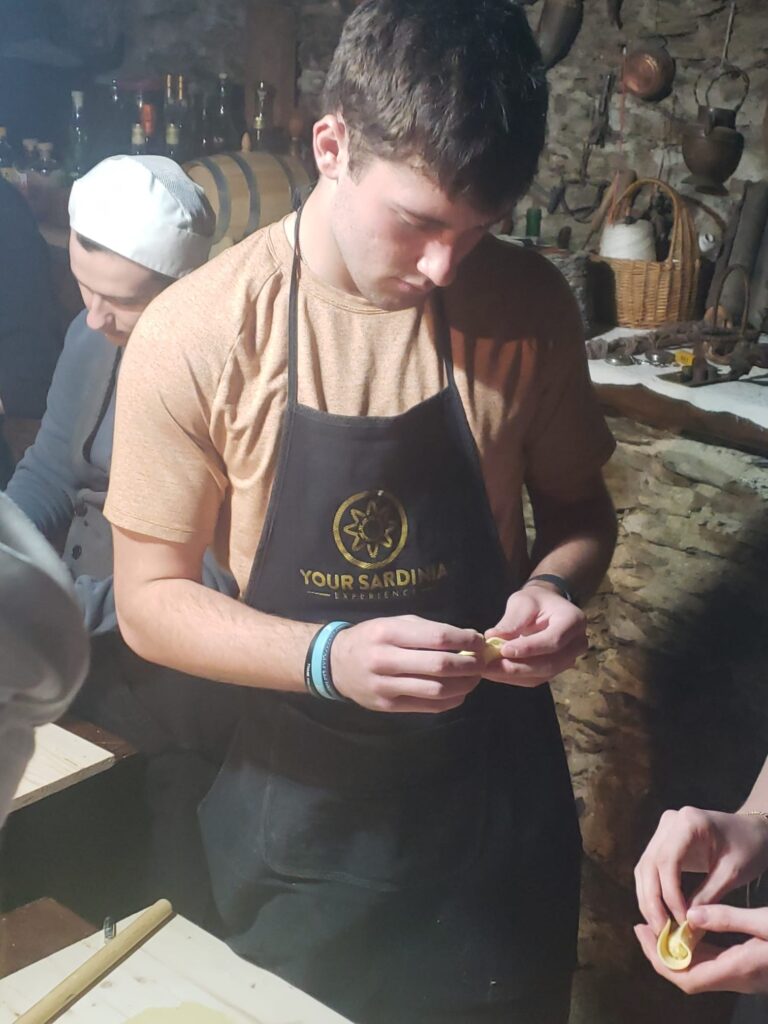
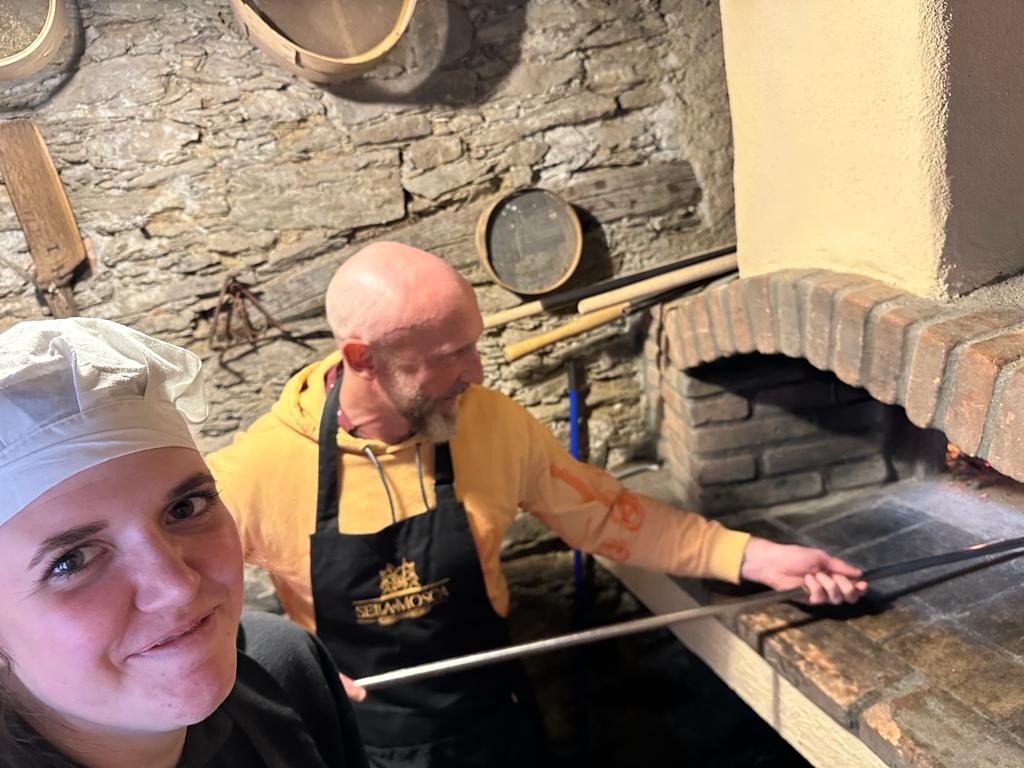
L’esperienza di una cena tipica non poteva mancare e, in questo caso, l’eccellenza del territorio si chiama Agriturismo Su Connotu.
In questi giorni, il gruppo è nelle mani dei ragazzi di Your Sardinia Experience, di Aritzo, con cui hanno già fatto un laboratorio di preparazione di malloreddus e culurgiones e si apprestano a scalare Perdas Carpias, ossia la vetta più alta dell’Isola, prima di spostarsi verso Olbia. Qui, la visita della capitale gallurese intende offrire un’esperienza più “da cartolina” e un’opportunità per discutere della costruzione di una Sardegna commercializzabile destinata allo “sguardo del turista” e a coloro che coltivano interessi economici esogeni.
Ho avuto l’onore di essere coinvolto da Marc Démont e Alessio Murru già nelle prime fasi di ideazione del tour. Perciò mi preme raccontarne la genesi e i vari passaggi che hanno portato all’esperienza in loco di cui ho appena raccontato.
Ho chiesto a Marc di farlo con le sue parole e questa è stata la risposta:
“L’idea di questo corso è nata mentre cercavo di costruire un semestre all’estero in Italia e mi sono reso conto di come Firenze, Roma e Milano si siano trasformate in grandi “fabbriche di studi all’estero” producendo e riproducendo i soliti cliché sull’Italia con, alla fine, ben poche opportunità di fare un’esperienza internazionale significativa. Ho deciso allora di offrire un’altra prospettiva, una prospettiva che guardasse all’Italia dalle sue periferie. La scelta della Sardegna era il naturale proseguimento della nostra collaborazione passata sul tema dell’intercomprensione sebbene adotti un approccio differente. E oggi eccoci qui nell’Isola, dopo che gli studenti hanno iniziato il loro percorso nel Kentucky con un corso intensivo sulla storia della Sardegna dalla sua età nuragica fino ai giorni nostri”.
Come sardi non possiamo che essere grati a Marc Dèmont per questo corso, ma più in generale per come tratta la questione sarda nella sua vita professionale. Se vi state chiedendo dove lo avete già sentito nominare, o se volete sapere qualcosina in più, guardate questo video. Marc è infatti stato ospite di Assemblea Natzionale Sarda a ottobre 2023 durante la scorsa edizione di Fàulas, il festival di ANS che ribalta i luoghi comuni della Sardegna.
Perciò grazie a Marc e grazie agli studenti del Centre College del Kentucky, che ripartiranno con un po’ di coscienza natzionale sarda nel loro bagaglio.
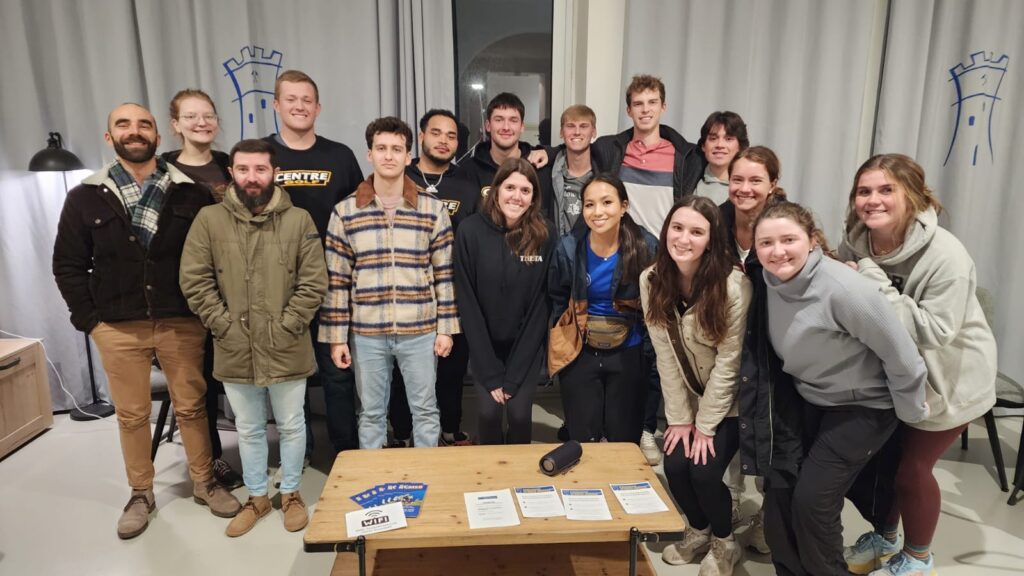
Immagini: Riccardo Pisu Maxia
Translated by Marc Démont.
14 students from the US to study the colonization of Sardinia
Can one learn about Sardinia by talking about social aspects and not always and only about perhaps coastal tourist attractions?
Definitely yes. Professor Marc Démont of Centre College in Danville, Kentucky, U.S.A., who is in Sardinia with 14 students to study closely aspects related to the colonization of the Island, is proving this in these weeks.
It is a course developed by the professor thanks to the support of his university, collaboration with pedagogue Alessio Murru and the help of many Sardinian social activists, artisans, entrepreneurs and teachers. The course is titled “Sardinia: Beyond the Colonial Postcard“, and focuses on the notion of internal colonization found in Sardinian subaltern studies.
Students are critically analyzing the relevance of this notion, examining three distinctive challenges facing the island: militarization (and public health), green energy, and Sardinian language and identity. The formative goal for students is to assess the relevance of the analytical framework of internal colonization to better understand these seemingly separate challenges.
The itinerary devised by Démont and collaborators included an initial stop in Cagliari, where Michela Foddis Saba expertly led the group on a tour through the center of Cagliari. The students were fascinated by the history of the city as told by Michela and the visit to the archaeological museum to the virtual experience of Nuragica. The following day saw them move on to Barumini to visit Su Nuraxi and the Giara.
The students then got to learn about the history of Carbonia, Italian fascism, and the importance of the exploitation of mineral resources in the history of Sardinia, thanks to the great professionalism of Federica Marrocu, guide and ANS member. Also in Carbonia, they participated in a hike to Mount Crobu and a conversation on the island’s prehistory with Manuel Cherchi, a poet and strong advocate for the Sardinian language and the preservation of the island. Professor Démont is convinced that it is through these kinds of collaborations and collaborators (F. Marrocu, M. Cherchi, E. Putzolu) that Carbonia’s heritage can be enhanced.
Something totally opposite to the usual tourist routes, in short. In fact, from January 16 to 20, the guys moved to the center of the island, to Mandrolisai precisely. Here they immediately received a warm welcome, since on the 16th, in Sòrgono, Sa Tùvera is lit and this event is celebrated around the big fire.
The following day they got to meet archaeologist Viviana Cau, who led them on a full immersion of pre-Nuragic and Nuragic history at the sites of Biru ‘e Concas and the archaic Nuraghe Talei. The students were amazed at how such a heritage does not receive the proper appreciation from institutions.
Following this, and building on this very question, I also had the pleasure of talking with the group and recounting what is for all intents and purposes a political and cultural problem. It was an opportunity to talk about what ANS – Sardinian National Assembly does in terms of political pressure on those who govern Sardinia and also in terms of growing national consciousness within society.
In the following stages, the U.S. students immersed themselves in the local reality in order to understand how people live in these latitudes, what they deal with and what knowledge they hold.
Thus, they did not miss a visit to a winery, specifically Cantina Mereu in Monte Pischina. Mandrolisai is indeed a land of excellent wines, and the students saw how the cultivation of vines, which represents one of the main local economies, takes place.
Francesca Mereu, of The Harvest of Merea, and Marianna Carta then led the students in a workshop of transformation from the raw material wheat to bread. Not to be left out, the group also tried their hand at pizza making, under the guidance of Antoni Murru.
The experience of a typical dinner could not be missed and, in this case, the excellence of the area is called Agriturismo Su Connotu.
These days, the group is in the hands of the guys from Your Sardinia Experience, from Aritzo, with whom they have already done a workshop on the preparation of malloreddus and culurgiones and are about to climb Perdas Carpias, that is, the highest peak on the island, before moving on to Olbia. Here, the visit to the Gallurese capital is intended to offer a more “postcard-like” experience and an opportunity to discuss the construction of a marketable Sardinia intended for the “tourist’s eye” and those cultivating exogenous economic interests.
I had the honor of being involved by Marc Démont and Alessio Murru early on in the conception stages of the tour. So I would like to recount its genesis and the various steps that led to the on-the-ground experience I have just recounted.
I asked Marc to do so in his own words and this was the answer:
“The idea for this course was born while I was trying to build a semester abroad in Italy and I realized how Florence, Rome and Milan have turned into big ‘study abroad factories’ producing and reproducing the usual clichés about Italy with, in the end, very few opportunities to have a meaningful international experience. I decided then to offer another perspective, one that looked at Italy from its peripheries. The choice of Sardinia was a natural continuation of our past collaboration on the theme of intercomprehension although taking a different approach. And today here we are on the Island, after the students began their journey in Kentucky with an intensive course on the history of Sardinia from its Nuragic age to the present day.”
As Sardinians we can only be grateful to Marc Dèmont for this course, but more generally for how he treats the Sardinian question in his professional life. If you are wondering where you have heard of him before, or if you want to know a little more, watch this video. In fact, Marc was a guest of Assemblea Natzionale Sarda in October 2023 during the last edition of Fàulas, ANS’s festival that overturns clichés about Sardinia.
So thanks to Marc and thanks to the students of Centre College in Kentucky, who will leave with some Sardinian national consciousness in their luggage.
















